Ajisai, or hydrangeas, are among Japan’s most beloved rainy season blooms. As June arrives and the skies turn overcast, these flowers quietly begin to colour temple gardens, mountain slopes, and even railway tracks in soft hues of blue, pink, and violet.
Unlike the fleeting spectacle of cherry blossoms, hydrangea season is slower, more contemplative. It invites a kind of travel that leans into the weather rather than avoiding it. If you’re planning a trip to Japan in early summer, these seven ajisai-viewing spots offer a quietly beautiful experience of the season.
Also read: How to Ride the Shinkansen in Japan: 8 Hacks Every Traveller Should Know
1. Meigetsuin Temple
Located in: Kamakura, Kanagawa Prefecture
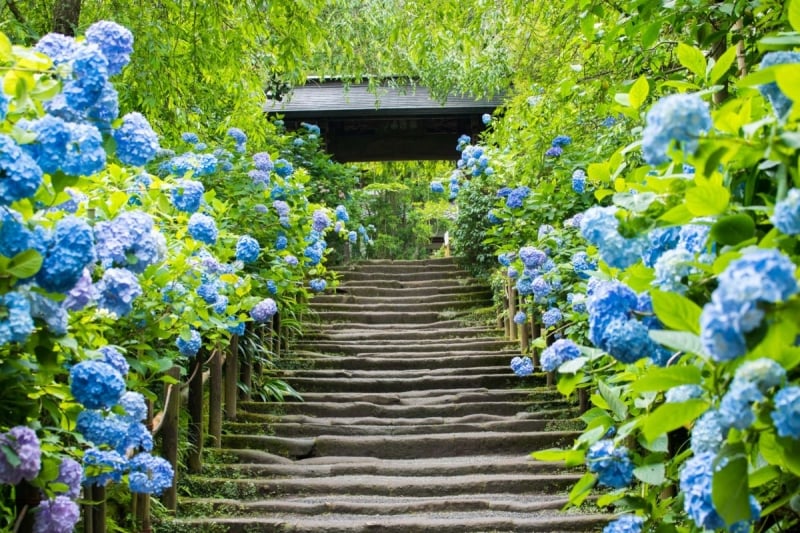
Image Credit: Japan National Tourism Organization Official Website
Meigetsuin is often referred to as the “Hydrangea Temple,” and for good reason. In June, over 2,500 hydrangeas bloom across its grounds, transforming the temple’s modest pathways into corridors of blue. The variety grown here is mostly a rich, clear shade that locals affectionately call “Meigetsuin Blue.”
Beyond the flowers, the temple is also known for its peaceful atmosphere. The narrow path leading to the main hall is lined with blossoms, and visitors often pause at the famous circular window to view the garden framed in near-perfect symmetry. Despite its popularity, there’s a hushed reverence that seems to settle over the grounds during ajisai season.
Address: 189 Yamanouchi, Kamakura, Kanagawa 247-0062
Best time to visit: 13 Jun – 27 Jun 2025
Access: 10-minute walk from Kita-Kamakura Station (JR Yokosuka Line)
2. Sanzenin Temple
Located in: Ohara, Kyoto Prefecture
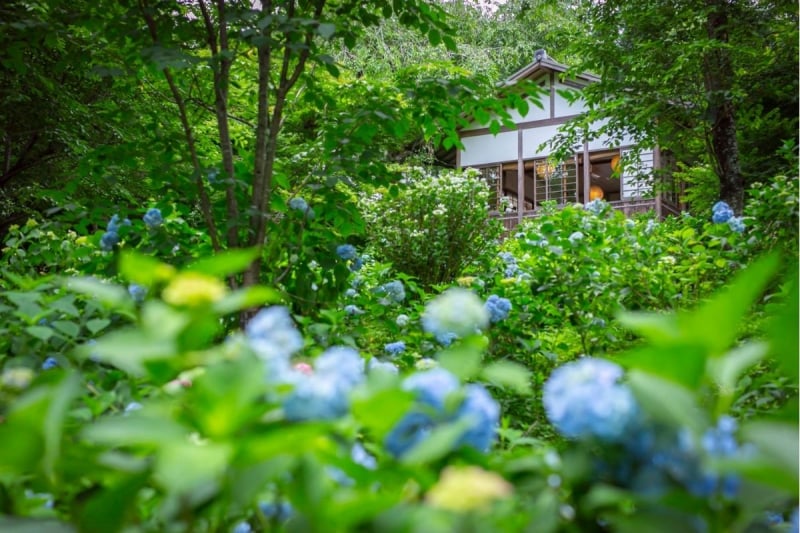
Image Credit: Japan National Tourism Organization Official Website
Set in the rural hills of Ohara, Sanzenin Temple offers a quieter, more atmospheric alternative to Kyoto’s more crowded sights. The temple is surrounded by gardens rich in moss, stonework, and tall cedars. During the ajisai season, hydrangeas bloom in clusters along the outer garden, blending seamlessly into the forested landscape.
This is a place that rewards slowness. You might spend as much time admiring the moisture-covered moss as you do the flowers themselves. In early summer, the air here tends to be cool and misty, adding to the sense of being gently tucked away from the world.
Address: 540 Ohara Raikoincho, Sakyo Ward, Kyoto 601-1242
Best time to visit: 15 June – 3 July 2025
Access: 25-minute bus ride from Kokusaikaikan Station, followed by a 10-minute walk
3. Hakusan Shrine
Located in: Bunkyo Ward, Tokyo
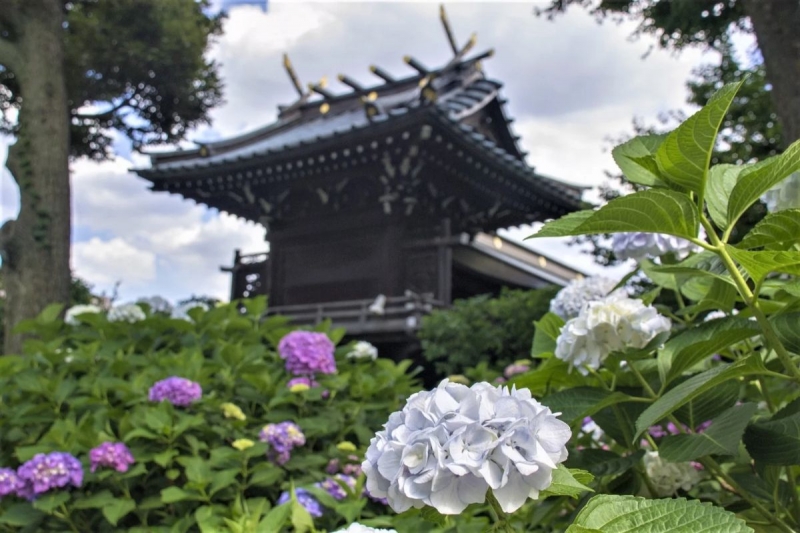
Image Credit: Go Tokyo Official Website
Tucked into a residential neighbourhood in central Tokyo, Hakusan Shrine is easy to miss during most of the year. But in June, it comes alive with nearly 3,000 hydrangea plants blooming around the shrine grounds and adjacent Hakusan Park.
It’s also the site of the Bunkyo Ajisai Festival, held annually in mid-June. The event is modest yet well-loved, featuring food stalls and live music on select weekends. For Tokyo residents, this shrine offers a pocket of seasonal charm without having to leave the city.
Address: 5-31-26 Hakusan, Bunkyo City, Tokyo 112-0001
Best time to visit: 13 Jun – 27 Jun 2025
Access: 5-minute walk from Hakusan Station (Toei Mita Line)
4. Shimoda Park
Located in: Shimoda, Shizuoka Prefecture
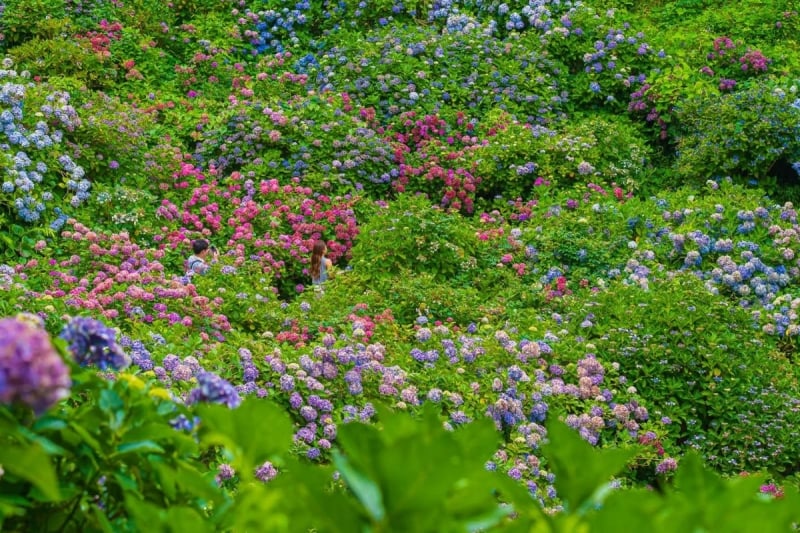
Image Credit: Japan National Tourism Organization Official Website
Shimoda Park is set on a coastal hillside overlooking Shimoda Bay. Every June, the park’s walking trails become a tapestry of over 3 million blooming hydrangeas, making it one of the largest ajisai displays in Japan. The park hosts the Shimoda Hydrangea Festival during this time, with performances and small food vendors on weekends.
What sets this spot apart is the view. The combination of vivid floral slopes with the ocean in the background gives the ajisai season here a broader, more expansive feel. It’s a reminder that beauty in Japan often emerges from the interplay between nature and place.
Address: 3-1174 Shimoda, Shizuoka 415-0023
Best time to visit: 17 Jun – 30 June 2025
Access: 10-minute bus ride from Izukyu-Shimoda Station
5. Katahara Onsen Ajisai-no-Sato
Located in: Gamagori, Aichi Prefecture
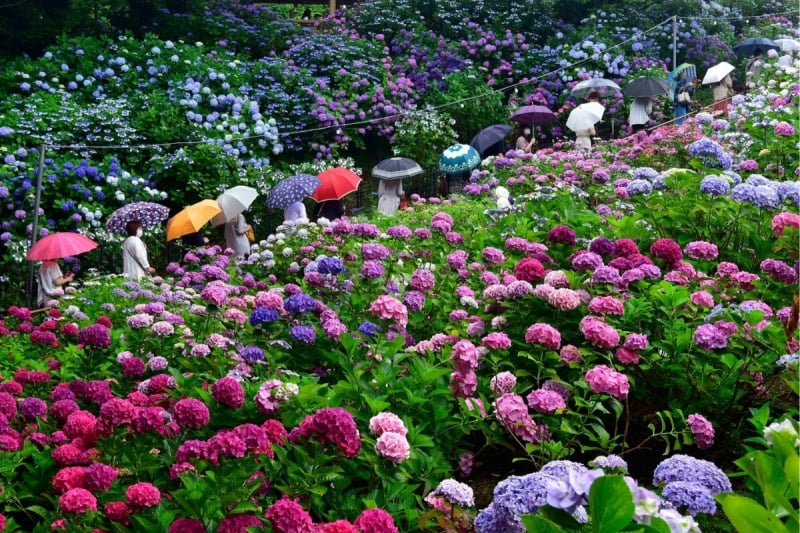
Image Credit: Japan National Tourism Organization Official Facebook Page
Ajisai-no-Sato is not just a hydrangea garden. It’s an entire seasonal experience. Located near the onsen town of Katahara, the park blooms with 50,000 hydrangeas in June, drawing visitors with its rare combination of floral beauty and natural magic. One of its most enchanting features is the appearance of glowing fireflies in the evenings, adding a quiet spectacle to your visit.
While the park is only open during the ajisai season, the experience is complete. You can visit the flowers by day, take a soak in the onsen, then return after dark to walk among illuminated blooms while fireflies drift nearby. It captures everything that’s special about this time of year — softness, warmth, and a sense of fleeting wonder.
Address: 1-1 Kataharacho Minamiyama, Gamagori, Aichi 443-0013
Best time to visit: 13 June – 30 June 2025
Access: 15-minute bus ride from Gamagori Station (JR Tokaido Line)
6. Cape Togenkyo
Located in: Kadogawa, Miyazaki Prefecture
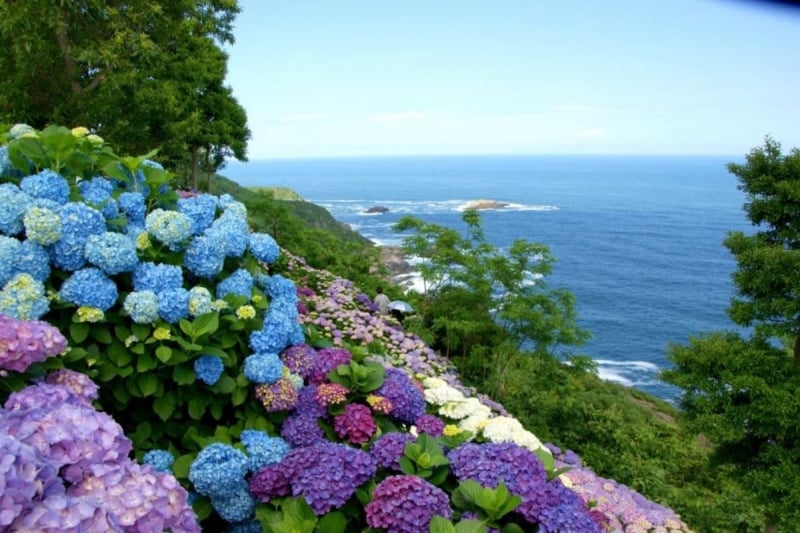
Image Credit: JR Kyushu Train& Travel Official Facebook Page
Cape Togenkyo is one of Kyushu’s most scenic places to view hydrangeas, set against the wide, open backdrop of the Hyuga-nada Sea. The cape’s gently sloping fields are covered in pastel blooms that roll toward the ocean, making it an ideal setting for a slow, reflective visit. It’s sometimes compared to Shimoda Park in Shizuoka, but with fewer crowds and a more relaxed atmosphere.
The name “Togenkyo” means paradise, and the landscape lives up to the name. During peak bloom, the flowers catch the ocean light and sway gently in the sea breeze. It’s a place that invites you to pause and take in both the view and the moment.
Address: Agawa, Kadogawa Town, Higashiusuki District, Miyazaki, Japan
Best time to visit: 25 May – 17 Jun 2025
Access: About 10 minutes by car from Kadogawa Station (JR Nippō Main Line)
7. Michinoku Hydrangea Garden
Located in: Ichinoseki, Iwate Prefecture
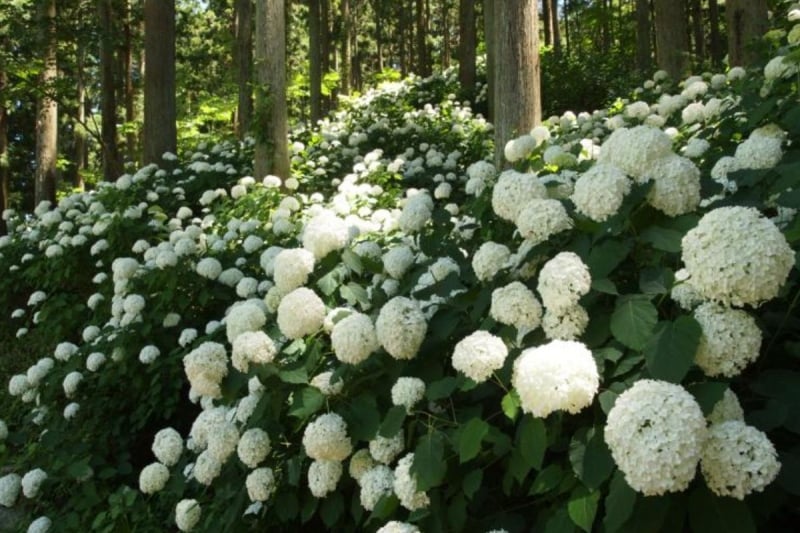
Image Credit: Iwate Tourism Association Official Website
Tucked in a cedar forest in northern Japan, the Michinoku Hydrangea Garden feels less like a manicured park and more like a living museum. The garden spans a vast area with over 400 varieties of hydrangeas blooming along walking paths, forest trails, and hillside streams. One of the most striking features is the “Hydrangea Pond,” where blossoms float gently on the surface, creating a scene that feels otherworldly.
Because of its northerly location, the ajisai here bloom later than in the rest of Japan. If you’re visiting in late June or early July, this is one of the best places to catch the tail end of the season. The garden isn’t particularly flashy. Instead, its appeal lies in how quietly it blends with the forest around it.
Address: 111 Harasawa, Maikawa, Ichinoseki, Iwate, Japan
Best time to visit: 25 June – 21 July 2025
Access: Around 30 minutes by car from JR Ichinoseki Station
Also read: A Guide to Goshuin Collecting in Japan: The Quiet Art of Shrine Stamps
Final thoughts: A season for slowness
The ajisai season doesn’t demand that you rush to catch it. Unlike sakura, there’s no single moment of full bloom to chase. Instead, these hydrangeas open gradually, over misty weeks in June, and ask only that you slow down and notice.
Whether you’re walking a quiet hillside trail, watching flowers pass from a train window, or pausing beneath a shrine’s eaves, the experience of ajisai in Japan leaves space for the small, sincere pleasures of the season.




